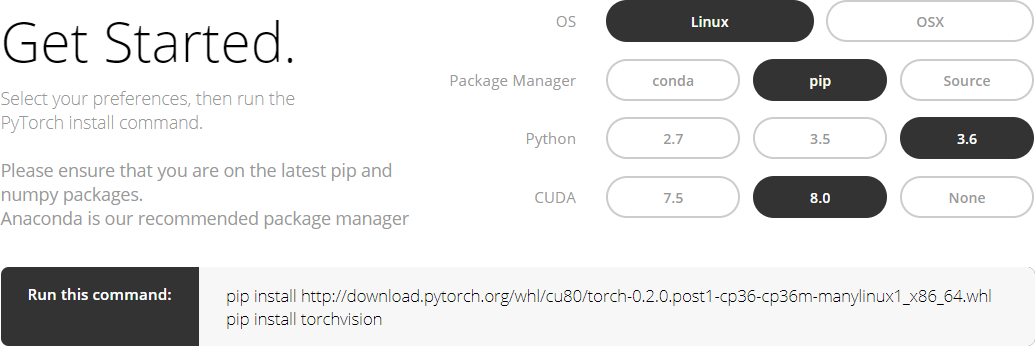Deep Learning Installation Tutorial - Index
Dear fellow deep learner, here is a tutorial to quickly install some of the major Deep Learning libraries and set up a complete development environment.
- Part 1 : Installation - Nvidia Drivers, CUDA and CuDNN
- Part 2 : Installation - Caffe, Tensorflow and Theano
- Part 3 : Installation - CNTK, Keras and PyTorch
- Part 4 : Installation - Docker for Deep Learning
Deep Learning Installation Tutorial - Part 3 - CNTK, Keras and PyTorch
There are a few major libraries available for Deep Learning development and research – Caffe, Keras, TensorFlow, Theano, and Torch, MxNet, etc. These libraries use GPU computation power to speed up deep neural networks training which can be very long on CPU (+/- 40 days for a standard convolutional neural network for the ImageNet Dataset).
NVIDIA is definitely the GPU brand to go for Deep Learning applications, and for now, the only brand broadly supported by deep learning libraries.
In these Tutorials, we will explore how to install and set up an environment to run Deep Learning tasks.
A few useful links :
- NVIDIA Drivers and Libraries:
- Deep Learning Libraries and Frameworks:
- Caffe: http://caffe.berkeleyvision.org
- Caffe2: https://caffe2.ai
- Microsoft Cognitive Toolkit: https://www.microsoft.com/en-us/cognitive-toolkit
- DeepLearning4J: https://deeplearning4j.org
- Keras: https://keras.io/
- Lasagne: http://lasagne.readthedocs.io/en/latest
- MxNet: http://mxnet.io
- PyTorch: http://pytorch.org/
- Tensorflow: https://www.tensorflow.org/
- TensorLayer: http://tensorlayer.readthedocs.io/en/stable/
- Theano: http://deeplearning.net/software/theano
- Torch: http://torch.ch
- Development Environments:
- Apache Singa: http://singa.apache.org
- DeepForge: https://github.com/deepforge-dev/deepforge
- Digits: https://developer.nvidia.com/digits
- Polyaxon: https://github.com/polyaxon/polyaxon
- Virtualisation Platforms:
- Docker: https://www.docker.com
- Nvidia-Docker: https://github.com/NVIDIA/nvidia-docker
In this post, we will install the following libraries:
- CNTK: "The Microsoft Cognitive Toolkit (https://cntk.ai), is a unified deep-learning toolkit that describes neural networks as a series of computational steps via a directed graph." (Source)
- Keras: "Keras is a high-level neural networks API, written in Python and capable of running on top of TensorFlow, CNTK, or Theano. It was developed with a focus on enabling fast experimentation. Being able to go from idea to result with the least possible delay is key to doing good research." (Source)
- PyTorch: "PyTorch is a Python package that provides Tensor computation (like NumPy) with strong GPU acceleration and Deep neural networks built on a tape-based autograd system" (Source)
A. Installing CNTK
The Microsoft Cognitive Toolkit - CNTK - is a unified deep-learning toolkit by Microsoft.
First, we need to install the dependencies:
sudo apt-get install openmpi-bin
Then we can install the correct binaries:
In order to install the CNTK library, please pick the correct link corresponding to your situation (you can find the latest versions on the official website)
Installing the chosen binary with pip:
# Python2
sudo pip install <url>
# Python3
sudo pip3 install <url>
Now let us perform a small test:
python
>>> import cntk
>>> cntk.__version__
'2.1'
B. Installing Keras
Keras is a high-level neural networks API, written in Python and capable of running on top of TensorFlow, CNTK, or Theano. It was developed with a focus on enabling fast experimentation. Being able to go from idea to result with the least possible delay is key to doing good research.
It is also one of the easiest library to install:
Installation:
# Python2
sudo pip install keras
# Python3
sudo pip3 install keras
Let us try the installation:
python
>>> import keras
>>> print(keras.__version__)
2.0.6
>>> print(keras.backend.backend())
'tensorflow'
Change the Keras Backend:
By default, Keras use Tensorflow as backend, if you prefer it can use CNTK or Theano.
import os, importlib
from keras import backend as K
def set_keras_backend(backend):
if K.backend() != backend:
os.environ['KERAS_BACKEND'] = backend
importlib.reload(K)
assert K.backend() == backend
set_keras_backend("theano")
set_keras_backend("tensorflow")
set_keras_backend("cntk")
C. Installing PyTorch
PyTorch is a deep learning framework that puts Python first.
This library is also quite easy to install:
I recommend using the official install command generator available on the official website.

# Python 2.7
pip install http://download.pytorch.org/whl/cu80/torch-0.2.0.post1-cp27-cp27m-manylinux1_x86_64.whl
pip install torchvision
# if the above command does not work, then you have python 2.7 UCS2, use this command
pip install http://download.pytorch.org/whl/cu80/torch-0.2.0.post1-cp27-cp27mu-manylinux1_x86_64.whl
pip install torchvision
# Python 3.5
pip3 install http://download.pytorch.org/whl/cu80/torch-0.2.0.post1-cp35-cp35m-manylinux1_x86_64.whl
pip3 install torchvision
# Python 3.6
pip3 install http://download.pytorch.org/whl/cu80/torch-0.2.0.post1-cp36-cp36m-manylinux1_x86_64.whl
pip3 install torchvision
Let us try the installation:
python
>>> import torch
>>> torch.manual_seed(1)
>>> V_data = [1., 2., 3.]
>>> V = torch.Tensor(V_data)
>>> print(V[0])
1.0
D. Conclusion
We have now installed CNTK, Keras and PyTorch. You can try to explore many of the available ressources online or keep installing the other libraries.





Comments !